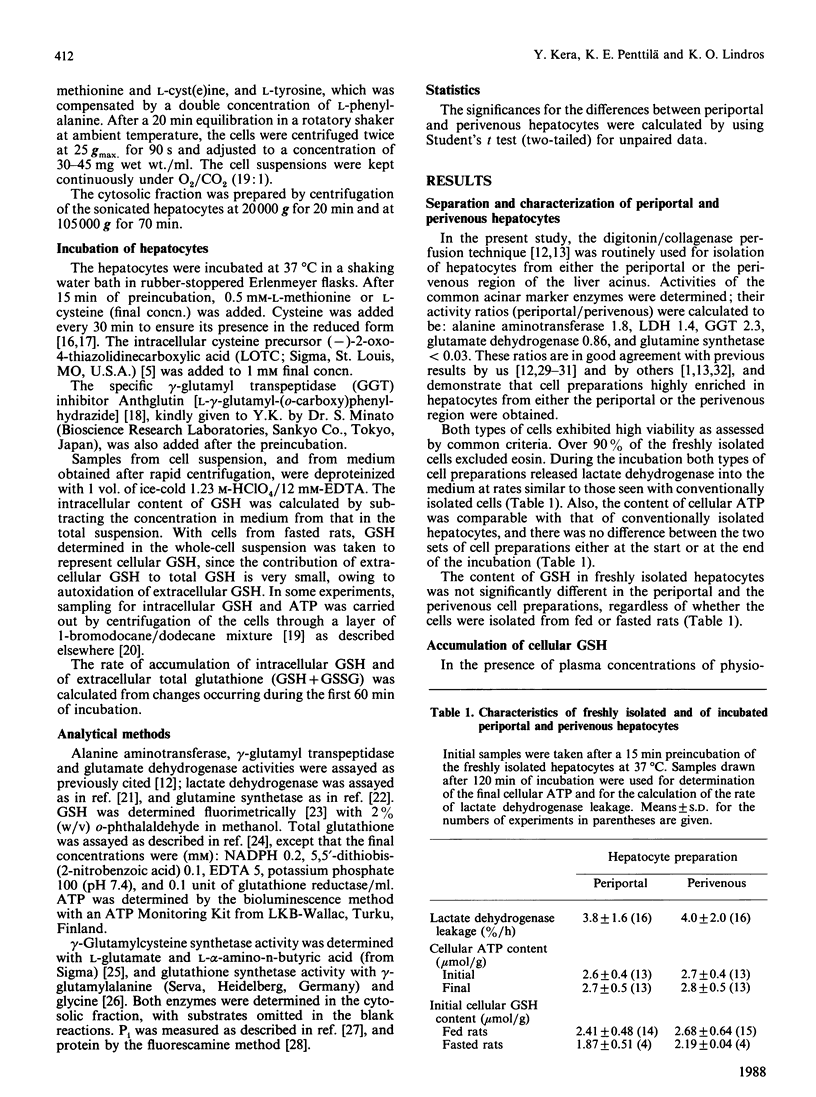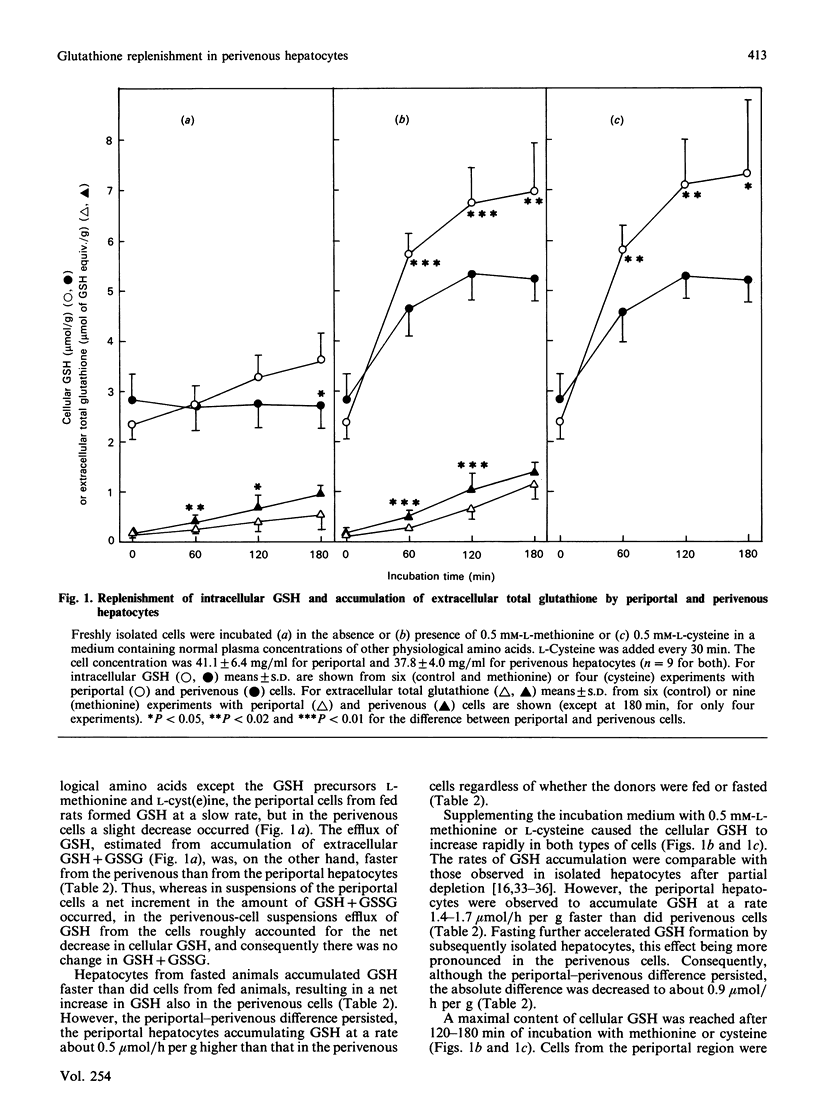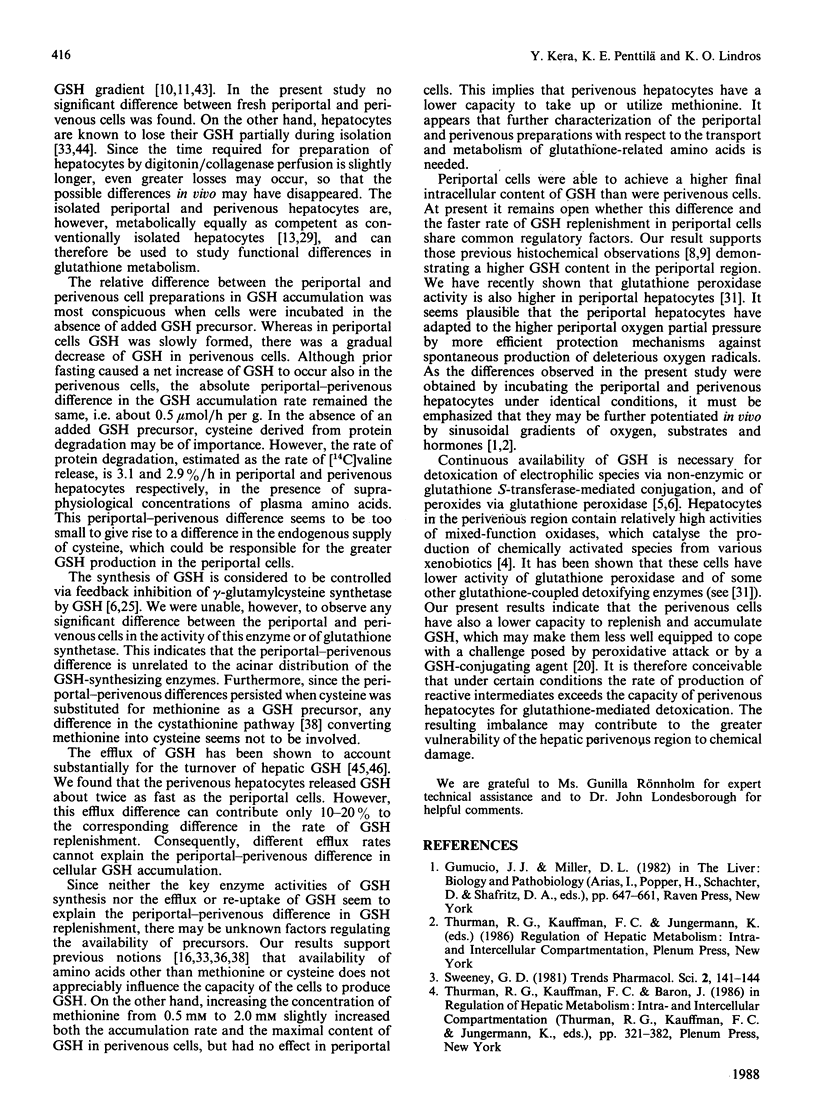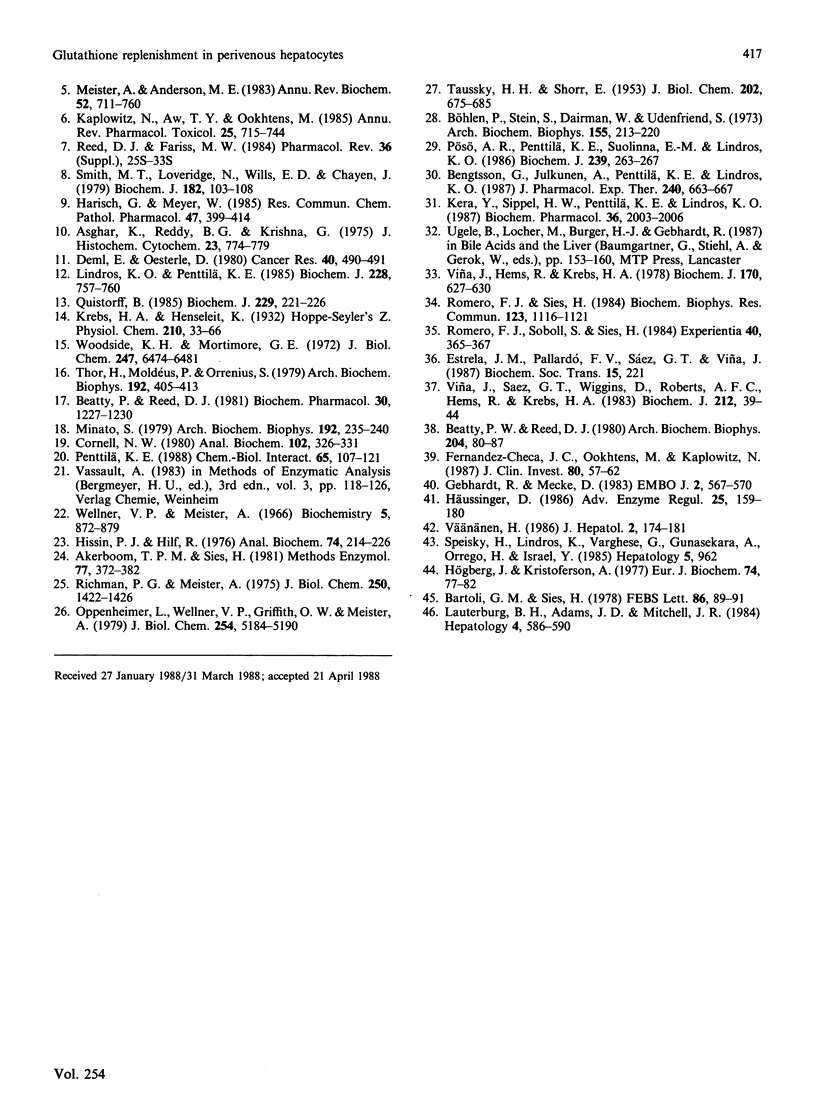Abstract
The zonal distribution of GSH metabolism was investigated by comparing hepatocytes obtained from the periportal (zone 1) or perivenous (zone 3) region by digitonin/collagenase perfusion. Freshly isolated periportal and perivenous cells had similar viability (dye exclusion, lactate dehydrogenase leakage and ATP content) and GSH content (2.4 and 2.7 mumol/g respectively). During incubation, periportal cells slowly accumulated GSH (0.35 mumol/h per g), whereas in perivenous cells a decrease occurred (-0.14 mumol/h per g). Also, in the presence of either L-methionine or L-cysteine (0.5 mM) periportal hepatocytes accumulated GSH much faster (3.5 mumol/h per g) than did perivenous cells (1.9 mumol/h per g). These periportal-perivenous differences were also found in cells from fasted rats. Efflux of GSH was faster from perivenous cells than from periportal cells, but this difference only explained 10-20% of the periportal-perivenous difference in accumulation. Furthermore, periportal cells accumulated GSH to a plateau 26-40% higher than in perivenous cells. There was no significant difference in gamma-glutamylcysteine synthetase or glutathione synthetase activity between the periportal and perivenous cell preparations. The periportal-perivenous difference in GSH accumulation was unaffected by inhibition of gamma-glutamyl transpeptidase or by 5 mM-glutamate or -glutamine, but was slightly diminished by 2 mM-L-methionine. This suggests differences between periportal and perivenous cells in their metabolism and/or transport of (sulphur) amino acids. Our results suggest that a lower GSH replenishment capacity of the hepatocytes from the perivenous region may contribute to the greater vulnerability of this region to xenobiotic damage.
Full text
PDF






Selected References
These references are in PubMed. This may not be the complete list of references from this article.
- Akerboom T. P., Sies H. Assay of glutathione, glutathione disulfide, and glutathione mixed disulfides in biological samples. Methods Enzymol. 1981;77:373–382. doi: 10.1016/s0076-6879(81)77050-2. [DOI] [PubMed] [Google Scholar]
- Asghar K., Reddy B. G., Krishna G. Histochemical localization of glutathione in tissues. J Histochem Cytochem. 1975 Oct;23(10):774–779. doi: 10.1177/23.10.53246. [DOI] [PubMed] [Google Scholar]
- Bartoli G. M., Sies H. Reduced and oxidized glutathione efflux from liver. FEBS Lett. 1978 Feb 1;86(1):89–91. doi: 10.1016/0014-5793(78)80105-7. [DOI] [PubMed] [Google Scholar]
- Beatty P. W., Reed D. J. Involvement of the cystathionine pathway in the biosynthesis of glutathione by isolated rat hepatocytes. Arch Biochem Biophys. 1980 Oct 1;204(1):80–87. doi: 10.1016/0003-9861(80)90009-0. [DOI] [PubMed] [Google Scholar]
- Beatty P., Reed D. J. Influence of cysteine upon the glutathione status of isolated rat hepatocytes. Biochem Pharmacol. 1981 Jun 1;30(11):1227–1230. doi: 10.1016/0006-2952(81)90302-6. [DOI] [PubMed] [Google Scholar]
- Bengtsson G., Julkunen A., Penttilä K. E., Lindros K. O. Effect of phenobarbital on the distribution of drug metabolizing enzymes between periportal and perivenous rat hepatocytes prepared by digitonin-collagenase liver perfusion. J Pharmacol Exp Ther. 1987 Feb;240(2):663–667. [PubMed] [Google Scholar]
- Böhlen P., Stein S., Dairman W., Udenfriend S. Fluorometric assay of proteins in the nanogram range. Arch Biochem Biophys. 1973 Mar;155(1):213–220. doi: 10.1016/s0003-9861(73)80023-2. [DOI] [PubMed] [Google Scholar]
- Cornell N. W. Rapid fractionation of cell suspensions with the use of brominated hydrocarbons. Anal Biochem. 1980 Mar 1;102(2):326–331. doi: 10.1016/0003-2697(80)90162-1. [DOI] [PubMed] [Google Scholar]
- Deml E., Oesterle D. Histochemical demonstration of enhanced glutathione content in enzyme-altered islands induced by carcinogens in rat liver. Cancer Res. 1980 Feb;40(2):490–491. [PubMed] [Google Scholar]
- Fernandez-Checa J. C., Ookhtens M., Kaplowitz N. Effect of chronic ethanol feeding on rat hepatocytic glutathione. Compartmentation, efflux, and response to incubation with ethanol. J Clin Invest. 1987 Jul;80(1):57–62. doi: 10.1172/JCI113063. [DOI] [PMC free article] [PubMed] [Google Scholar]
- Gebhardt R., Mecke D. Heterogeneous distribution of glutamine synthetase among rat liver parenchymal cells in situ and in primary culture. EMBO J. 1983;2(4):567–570. doi: 10.1002/j.1460-2075.1983.tb01464.x. [DOI] [PMC free article] [PubMed] [Google Scholar]
- Harisch G., Meyer W. Studies on tissue distribution of glutathione and on activities of glutathione-related enzymes after carbon tetrachloride-induced liver injury. Res Commun Chem Pathol Pharmacol. 1985 Mar;47(3):399–314. [PubMed] [Google Scholar]
- Hissin P. J., Hilf R. A fluorometric method for determination of oxidized and reduced glutathione in tissues. Anal Biochem. 1976 Jul;74(1):214–226. doi: 10.1016/0003-2697(76)90326-2. [DOI] [PubMed] [Google Scholar]
- Häussinger D. Regulation of hepatic ammonia metabolism: the intercellular glutamine cycle. Adv Enzyme Regul. 1986;25:159–180. doi: 10.1016/0065-2571(86)90013-0. [DOI] [PubMed] [Google Scholar]
- Högberg J., Kristoferson A. A correlation between glutathione levels and cellular damage in isolated hepatocytes. Eur J Biochem. 1977 Mar 15;74(1):77–82. doi: 10.1111/j.1432-1033.1977.tb11368.x. [DOI] [PubMed] [Google Scholar]
- Kaplowitz N., Aw T. Y., Ookhtens M. The regulation of hepatic glutathione. Annu Rev Pharmacol Toxicol. 1985;25:715–744. doi: 10.1146/annurev.pa.25.040185.003435. [DOI] [PubMed] [Google Scholar]
- Kera Y., Sippel H. W., Penttilä K. E., Lindros K. O. Acinar distribution of glutathione-dependent detoxifying enzymes. Low glutathione peroxidase activity in perivenous hepatocytes. Biochem Pharmacol. 1987 Jun 15;36(12):2003–2006. doi: 10.1016/0006-2952(87)90500-4. [DOI] [PubMed] [Google Scholar]
- Lauterburg B. H., Adams J. D., Mitchell J. R. Hepatic glutathione homeostasis in the rat: efflux accounts for glutathione turnover. Hepatology. 1984 Jul-Aug;4(4):586–590. doi: 10.1002/hep.1840040402. [DOI] [PubMed] [Google Scholar]
- Lindros K. O., Penttilä K. E. Digitonin-collagenase perfusion for efficient separation of periportal or perivenous hepatocytes. Biochem J. 1985 Jun 15;228(3):757–760. doi: 10.1042/bj2280757. [DOI] [PMC free article] [PubMed] [Google Scholar]
- Meister A., Anderson M. E. Glutathione. Annu Rev Biochem. 1983;52:711–760. doi: 10.1146/annurev.bi.52.070183.003431. [DOI] [PubMed] [Google Scholar]
- Minato S. Isolation of anthglutin, an inhibitor of gamma-glutamyl transpeptidase from Penicillum oxalicum. Arch Biochem Biophys. 1979 Jan;192(1):235–240. doi: 10.1016/0003-9861(79)90088-2. [DOI] [PubMed] [Google Scholar]
- Oppenheimer L., Wellner V. P., Griffith O. W., Meister A. Glutathione synthetase. Purification from rat kidney and mapping of the substrate binding sites. J Biol Chem. 1979 Jun 25;254(12):5184–5190. [PubMed] [Google Scholar]
- Penttilä K. E. Allyl alcohol cytotoxicity and glutathione depletion in isolated periportal and perivenous rat hepatocytes. Chem Biol Interact. 1988;65(2):107–121. doi: 10.1016/0009-2797(88)90048-8. [DOI] [PubMed] [Google Scholar]
- Pösö A. R., Penttilä K. E., Suolinna E. M., Lindros K. O. Urea synthesis in freshly isolated and in cultured periportal and perivenous hepatocytes. Biochem J. 1986 Oct 15;239(2):263–267. doi: 10.1042/bj2390263. [DOI] [PMC free article] [PubMed] [Google Scholar]
- Quistorff B. Gluconeogenesis in periportal and perivenous hepatocytes of rat liver, isolated by a new high-yield digitonin/collagenase perfusion technique. Biochem J. 1985 Jul 1;229(1):221–226. doi: 10.1042/bj2290221. [DOI] [PMC free article] [PubMed] [Google Scholar]
- Reed D. J., Fariss M. W. Glutathione depletion and susceptibility. Pharmacol Rev. 1984 Jun;36(2 Suppl):25S–33S. [PubMed] [Google Scholar]
- Richman P. G., Meister A. Regulation of gamma-glutamyl-cysteine synthetase by nonallosteric feedback inhibition by glutathione. J Biol Chem. 1975 Feb 25;250(4):1422–1426. [PubMed] [Google Scholar]
- Romero F. J., Sies H. Subcellular glutathione contents in isolated hepatocytes treated with L-buthionine sulfoximine. Biochem Biophys Res Commun. 1984 Sep 28;123(3):1116–1121. doi: 10.1016/s0006-291x(84)80248-x. [DOI] [PubMed] [Google Scholar]
- Romero F. J., Soboll S., Sies H. Mitochondrial and cytosolic glutathione after depletion by phorone in isolated hepatocytes. Experientia. 1984 Apr 15;40(4):365–367. doi: 10.1007/BF01952555. [DOI] [PubMed] [Google Scholar]
- Smith M. T., Loveridge N., Wills E. D., Chayen J. The distribution of glutathione in the rat liver lobule. Biochem J. 1979 Jul 15;182(1):103–108. doi: 10.1042/bj1820103. [DOI] [PMC free article] [PubMed] [Google Scholar]
- TAUSSKY H. H., SHORR E. A microcolorimetric method for the determination of inorganic phosphorus. J Biol Chem. 1953 Jun;202(2):675–685. [PubMed] [Google Scholar]
- Thor H., Moldéus P., Orrenius S. Metabolic activation and hepatotoxicity. Effect of cysteine, N-acetylcysteine, and methionine on glutathione biosynthesis and bromobenzene toxicity in isolated rat hepatocytes. Arch Biochem Biophys. 1979 Feb;192(2):405–413. doi: 10.1016/0003-9861(79)90109-7. [DOI] [PubMed] [Google Scholar]
- Viña J., Hems R., Krebs H. A. Maintenance of glutathione content is isolated hepatocyctes. Biochem J. 1978 Mar 15;170(3):627–630. doi: 10.1042/bj1700627. [DOI] [PMC free article] [PubMed] [Google Scholar]
- Viña J., Saez G. T., Wiggins D., Roberts A. F., Hems R., Krebs H. A. The effect of cysteine oxidation on isolated hepatocytes. Biochem J. 1983 Apr 15;212(1):39–44. doi: 10.1042/bj2120039. [DOI] [PMC free article] [PubMed] [Google Scholar]
- Vänänen H. The distribution of cytochrome P-450-mediated drug oxidation and glutathione in periportal and perivenous rat hepatocytes after phenobarbital treatment. J Hepatol. 1986;2(2):174–181. doi: 10.1016/s0168-8278(86)80076-9. [DOI] [PubMed] [Google Scholar]
- Wellner V. P., Meister A. Binding of adenosine triphosphate and adenosine diphosphate by glutamine synthetase. Biochemistry. 1966 Mar;5(3):872–879. doi: 10.1021/bi00867a010. [DOI] [PubMed] [Google Scholar]
- Woodside K. H., Mortimore G. E. Suppression of protein turnover by amino acids in the perfused rat liver. J Biol Chem. 1972 Oct 25;247(20):6474–6481. [PubMed] [Google Scholar]


